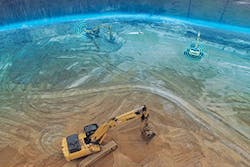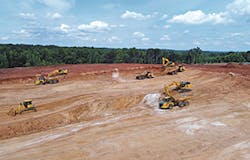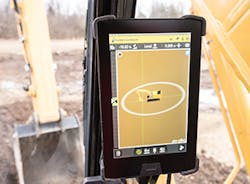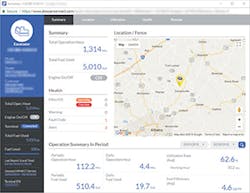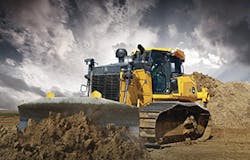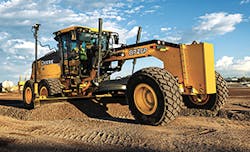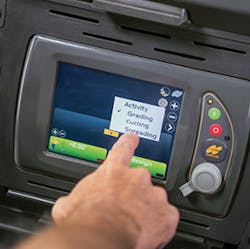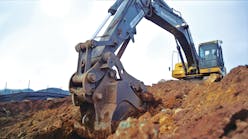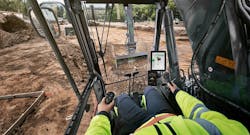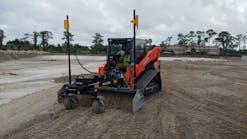Telematics has been around for some time, but early iterations covered little more than the basics: machine hours, accurate location, maintenance due, and geo-fencing. Today, telematics offers more sophistication, says Tom Remy, senior manager/aftermarket sales for Topcon Tierra.
Expanding offerings serve as incentives, but the adoption curve has risen sharply in large part because telematics is more available. Many OEMs include telematics packages free for three years—and Komatsu offers it free for life, Remy says. Aftermarket telematics packages are also popular. “Ten years ago, the adoption curve was less than 10%, but recent surveys put it at 17% to 29% today.”
Doosan has offered telematics since 2008. Aaron Kleingartner, marketing manager, describes the early version as an “off-the-shelf installation of hardware that indicated location, battery level, and service notices.” But not much more. Now, however, he says it has “lots of capabilities.” The hardware is integrally designed and has access to CAN bus data from the machine. In addition to location, it provides specific code warnings and alerts that connect to the machine to let the customer manage the machine.
Notifications, alerts, and warnings are detailed and at different levels for the fleet manager, owner, and site manager, Kleingartner explains and can be accessed via an online web-based interface or via a mobile device. Easy-to-read reports cover fuel use, the number of minutes spent in each of four power modes, and idle time.
Drone monitoring Komatsu equipment
The theory of telematics technology has remained relatively static, states Ronak Amin, manager, business solutions, Komatsu America Corp. However, the capabilities of the system have changed sharply over the years. “Telematics has grown beyond simple asset tracking into a system that can help end-users manage their operating expenses, more accurately estimate their jobs, improve productivity, and identify wasted resources.”
The current and most sophisticated telematics systems will provide users with comprehensive data from their machines, the ability to set up alerts, create geo-fences, and provide a robust fleet summary that allows them to benchmark their performance. Most equipment manufacturers offer a factory-installed telematics system that will allow the customer, dealer, and manufacturer to receive real-time operating information such as fuel usage, performance, and location directly from the machine. Telematics also assists with machine maintenance by reporting error codes and service information to the service department or fleet manager. This allows technicians to troubleshoot issues remotely, identify the necessary parts, and conduct onsite repairs.
Kobelco Excavator equipped with Trimble
Machine Control
Kobelco excavators come standard with KOMEXS, an online machine monitoring system that reports back to a general server and is accessible by customer and dealer. It monitors fuel consumption, hours of work, fuel levels, machine load, digging hours, idle time, break times, scheduled maintenance, and fault codes, says George Lumpkins, product marketing and developing general manager for Kobelco USA.
“We changed our approach two years ago,” says Dave Adams, product sales manager for connected services, Volvo CE. The norm, he explains, was to give the customer a log-in to look at the telematics. “We left it to the customer to manage data.” But they started doing it for the customer, using a team of specialists who monitor the machines around the clock and decipher the data as part of their ActiveCare Direct program. If the machines are “out of normal,” he says, the team sends an email to the customer and notifies the dealer—often, before the customer knows there’s an issue. This helps avoid downtime and catastrophic failure.
Although it’s possible to customize what is monitored, Adams says anything that impacts the machine or causes downtime is classified as priority. Monthly reports provide information on idle time, fuel burn, machine misuse, and routine maintenance. “We give only valuable data.”
The acquisition of data is evolving. In the early days, says Paul Garcia, product manager, John Deere WorkSight, there was such an overwhelming amount of data that contractors didn’t know what to do with it. Now, he adds, data can provide insights.
Telematics does fleet management for the customer. Adams mentions one customer that saved $1 million due to lack of downtime, saved fuel, and reduced wear and tear because they were proactive before issues arose.
Machine health monitoring is done at the dealer and factory levels to help businesses run better. Telematics can reveal how utilized the machines are and if the contractor is making the best use of the equipment to improve productivity. It also indicates fuel consumption and idle time.
As telematics provides more data, more uses for that data are being found. “Dealers use information collected to identify trends indicating the need for service or repair to avoid unscheduled downtime. The factory analyzes data from across the US and Canada to identify problems and develop recommendations,” says Garcia.
Multiple data categories in DoosanCONNECT
Geo-Fence
The use of telematics has moved past fleet maintenance, health, and asset tracking into production and planning, says Amin. “Telematics data has also expanded into previously unconnected systems, making the data richer and more useful.”
Telematics is becoming an industry standard, Lumpkins believes, adding that it can help businesses. For example, the use of telematics reduces downtime and optimizes fuel economy. The ability to produce error codes for the dealer and customer is also a benefit—especially because an operator may ignore error codes and continue working. “Geo-fencing is also becoming more and more important, especially in certain areas with [an] increase in machine theft.”
Many grading and excavation contractors operate in rural or remote areas, which can make unattended equipment the target of thieves. Hyundai’s Hi-MATE system monitors the machine’s status and location and provides alarm notification if the machine leaves its designated area or operates in any unauthorized way, says Michael Fuller, product and training specialist for Hyundai Construction Equipment Americas.
Geo- and time-fences for curfews are recent additions for Doosan. Kleingartner says some customization is possible, such as selecting the radius and receiving an alert if the machine leaves the area of work after hours. “Large equipment is less prone to theft, but if theft and vandalism are concerns, all it takes is one issue, due to the cost of this machinery.”
With telematics, contractors know each machine’s location and working mode: key on, key off, idling, or at full speed. Idling for no reason wastes fuel, is bad for the environment and emissions systems, wastes machine hours, and affects oil change cycles and the warranty. But telematics can eliminate idling for no reason.
Other benefits of telematics Kleingartner mentions include optimizing maintenance timing and utilization on the job site. An unexpected benefit comes from the level of information and how it reveals trending data, such as current hours used per day or week. “It helps contractors plan jobs and bid jobs more accurately.” It also helps them save money in fuel and reduce the number of operating hours with automatic shut-down.
Telematics points out that machines may not need daily fueling, Remy interjects. That can be a time-saver, just as geo-fencing is. “You can do job-costing through geo-fencing by tracking equipment on each job site in real time—tracking hours and change orders.” All that used to be tracked by pen and paper, he says, which often lagged behind by 30 days.
Productivity and Uptime
Knowing where the machines are and if they’re working or not is important—even more so when contractors are working at quarries or new sites that don’t have addresses. Garcia says that apps like JDLink Mobile help by providing driving directions
to the machine.
It’s that level of granular data that increases the productivity of both machine and operator, Garcia insists. Other useful JDLink data includes diesel emission fluid (DEF) and fuel tank levels to plan refueling, tire pressure monitoring to prevent premature tire wear, fluid temperature monitoring to prevent overheating, and reverse to minimize undercarriage wear. “It’s almost like putting two people in the cab; the operator concentrates on completing the job and the fleet manager keeps the machine up and running.”
Additional information that can be seen by the fleet manager and the dealer includes the percentage of time when grade control is being used, the load factor—how hard the machine gets worked—and payload on dump trucks. Alerts can also be filtered for maintenance or for emerging issues.
The need for real-time information about equipment status, productivity, location, and other vital operating parameters is crucial to the success of today’s grading and excavation contractor, Fuller says. “It’s really all about maximizing uptime. The successful contractor is focused on achieving the highest productivity and best possible return on every valuable piece of equipment. A GPS-based system like HiMATE enables a contractor to track, trace, and monitor vital service, diagnostic, and operations data any time from any location.”
Benefits include an archived operating history, real-time alarm information, theft prevention, fuel management data, and equipment performance reports. Real-time machine diagnostics also help minimize unaffordable downtime and the need to rely on rental machines in the case of an unexpected failure.
HiMATE provides real-time monitoring of every machine plotted on a digital map. This includes color-coding of each machine icon on the map to indicate service status and location. If the machine icon is blue, then the machine is operating normally. If the machine icon is red, then the machine has logged an alarm. By clicking on the individual machine icon, a use can view more detail regarding current status.
Contracts are tight, so contractors can’t afford downtime or keeping extra machines on standby for emergency backup, says Adams. That’s why Volvo sees a need to improve management and uptime. “Our focus is on fleet and site management.” Accessing reports via telematics provides crucial information that assists contractors in bidding on contracts as well as maintaining the equipment.
Remote
Hyundai recognized the value of remote management and diagnostic systems long ago and their proprietary Hi-MATE remote management system is included with all Hyundai wheel loaders and full-sized excavators at no charge for the first five years of ownership, Fuller continues.
Hi-MATE can send and receive data from machines in the field via smartphones or the mobile app from the Google Play store using cellular networks or—with additional hardware and a subscription—satellites. The remote management system reduces administrative time and expense by storing maintenance, fuel usage, hours of operation, and other data and generating reports.
Takeuchi Fleet Management (TFM), which is standard equipment on excavators and track loaders during the warranty period, is a telematics remote monitoring solution intended to improve machine management and efficiency. Users have access to data that includes run hours, location, engine fuel rate, urea level, battery voltage, and fuel level. Engine data and error codes are also available.
“We believe it will provide users with increased value, a greater capacity to maximize profitability, reduce downtime, and improve efficiency,” says Johnny Martinez, TFM manager. He says knowing where the equipment is and what it’s doing is standard for any telematics program, but that Takeuchi hopes to add functions such as remote regeneration—made necessary because of clogged DPF filters—which would eliminate a service call and get the machine running within an hour.
Other remote functions that Martinez says receive interest are placing machines in a “creep mode” or disabling them once they are outside of a specified virtual boundary.
A John Deere 950K equipped with SmartGrade
Branding
No contractor uses only one brand, Topcon’s Remy observes. Because of that, it used to be difficult to manage job sites. However, Topcon Tierra’s “total fleet” aftermarket solution brings all OEM platforms together on one website. “It’s accomplished through AEMP telematics standards,” he says, and is capable of handling “big data.”
Managers of fleets with different brands of equipment want to see the data for all of them. Garcia says Deere works with four mixed-fleet providers that display the telematics information of a mixed fleet within a single portal, regardless of brand. JD-Link can outbound a specific data feed in accordance with ISO standards to enable visualization of Deere equipment within a mixed-fleet portal.
Since systems are proprietary to each manufacturer, companies like Trimble are working to bring a universal platform to the market to allow customers one system and one dashboard to monitor their multi-branded fleet, Lumpkins reports. “Although this won’t allow all of the detailed information that the OEM system may get, it is more than enough to assist them in making business and service decisions.”
Similarly, Hitachi’s ZXLink maximizes productivity and uptime with access to fleet location, functions, hours, fuel consumption, alerts, and other data viewable remotely. ZXLink Select can be installed on any brand of equipment, allowing a contractor to track machine hours, location, maintenance, and geo-fencing for the entire fleet on one website. ZXLink Ultimate works on all brands, providing alerts and diagnostic codes.
Blending Technologies
Not only do some telematics systems work on multiple brands, but they work with other technologies too. Amin says some end-users merge telematics data with other systems, such as payroll and accounting, project management, dispatching and scheduling, and estimating and bidding. “Ten years ago, it would be quite unexpected to have told an end-user that they can use telematics to analyze their equipment cycles times, coach their equipment operators, and aid in estimating and bidding.
“The future is all about the verticals,” Amin continues. He believes that introducing data from machine control systems, drones, or even concrete mixing plants, payload scales, or aggregate-crushers elevates telematics to the next level.
For example, if a telematics system has recorded that fuel consumption on a fleet of off-road haul trucks at a job site is much higher than expected, a drone can be deployed at the job site, providing data that indicates that the haul road being used is too steep and in need of maintenance. The two data sets together have concluded the root cause of an issue. There’s even a lot of other data out there that’s independent of the job site but can directly affect job performance, such as weather, traffic patterns, or even geopolitical events.
Several companies are offering GPS systems that will work in unison with the machine to provide accurate real-time data to map. This same system can assist the operator in controlling some of the functions of the machine to ensure that the grade matches the pre-programmed data.
Kobelco has worked closely with Trimble for years to develop one of the most advanced control systems installed on their excavators, says Lumpkins. “All the operator has to do is raise the boom and the GPS system will control the arm and bucket function to ensure the proper grade is achieved.”
The system does not use specialized electronic sensor cylinders or mechanically controlled-position sensors. Instead, it uses newly developed state-of-the-art gyroscopic sensors similar to those used in modern airliners and stability systems on automobiles.
It has three different levels of usage:
- Grade Assist – The operator will be able to monitor the position of the bucket or working tool in relation to the machine.
- 2D Machine Control – With the assistance of a laser system and additional sensors, this provides a height and slope reference to the operator. The system and operator can manually or automatically control the machine to recreate the programed elevations.
- 3D Machine Control – With the addition of a Global Navigation Satellite System, receivers, and pre-programmed engineering plans, the machine can be manually or automatically controlled to match a three-dimensional set designed for the groundwork. With this system, multiple machines can work together to meet the engineers’ design.
The next item for machine productivity data is to quantify the number of yards of dirt, Remy states. “If you over-pave by half an inch, that’s a lot of waste. We measure in milliliters for less waste.” Drones—particularly in the ag industry—can help reduce or eliminate waste in materials and indicate compaction rates by creating a 3D map through aerial imaging. They also allow the farmer to see the health of the crops as well as of the machines. However, while commonly used for agriculture, drone images are in the construction industry’s future as well.
Drones can provide data about the job site, Garcia says. The speed at which drones can capture survey grade topography is unmatched. “The adoption curve will continue to climb as more construction customers reap the benefits of having updated topography at their fingertips.”
Topcon is also working on integrating data for blade control and machine control with telematics. However, machine control and telematics are different. Telematics enables machine control. Telematics captures diagnostic information and keeps grade control going.
A John Deere 872GP equipped with grade control
Got the Blues?
Another form of technology gaining rapid acceptance for use with telematics is Bluetooth. Topcon Tierra is testing Bluetooth tags on attachments. “Attachments get lost,” states Remy. “This saves on lost equipment and on time searching for it.”
Low-energy (LE) Bluetooth is a new development. Cell phones use up a lot of battery and don’t always work in remote locations. “Some people don’t have cell phones; some don’t have good cell coverage,” adds Remy.
LE Bluetooth is used in on-highway applications to track and log issues and manage fuel deliveries and inspections. “It’s a management strategy that is more efficient,” believes Remy, “but it’s in the infancy of efficiency for the construction industry.”
Deere is transitioning from 3G to 4G to deliver additional processing capability and memory, as well as Wi-Fi and Bluetooth capability, Garcia says. “Wi-Fi is an alternative to transmitting data by cellular. This is particularly useful in areas where cell connectivity can be difficult.” Bluetooth is short-range communication to connect with Wi-Fi, he explains, and will eventually enable machine-to-machine and machine-to-person communication.
The John Deere 700K SmartGrade monitor
Cellular, Wi-Fi, and Bluetooth: what do you do with it all? OEM Data Delivery, a sub-division of OEM Controls, provides Bluetooth wireless hour meters that allow communication to be captured by cellular telematics, Wi-Fi routers, and smartphone mobile apps.
“We work with customers and telematics companies to extend and enhance their technology,” says Sam Simons. Because Bluetooth 4.x is low energy and its beacon extends a greater distance, smaller assets and attachments can be tracked.
“Telematics, Wi-Fi, and smart devices create a network for capturing the data tracked by Bluetooth. In addition to capturing the hours, the location of the asset is collected by this network,” explains Simons. Bluetooth enables the capture of all equipment and attachments—not just the big pieces. That benefits complete asset inventory and utilization.
Simplicity
Installation of aftermarket devices can be as simple as connecting three wires and using high-powered magnets to mount—no drilling required, says Remy. “There are plug-and-play cables for the CAN bus connector on machines, so you can recover the system if you sell the machine.” Contractors can track rental machines and rental houses can track hours.
Six to seven parameters can be captured in the J1939 protocol from Topcon. CAN bus data from the electronic control module in the machine records fuel consumption, RPM, engine coolant temperature, hydraulic temperature, and more.
Although more data is captured, it has been simplified. “People used to get bombarded with data,” continues Remy, “but we put it in a graphical format, using graphs and PDFs so it’s easy to share, configure, and manipulate. They can filter out what they don’t need. We can reduce the flow of data until it hits predetermined markers, which can be set for hours or the job.”
“Our focus is uptime,” says Adams. “Volvo monitors the machines and keeps the data. We see issues on machines before the customer does; we see trends.” He says he knew there’d be savings, but he had no idea it would be so much. However, his biggest surprise is how much time savings there’s been by eliminating the “noise” of too much data. Streamlining data to provide only what is valuable to the customer eliminates the “noise” that comes from the machines.
That’s where telematics is at its best, Amin believes. He says that one of the barriers to making the greatest use of telematics is that people think the traditional approach requires additional effort: data mining websites, connecting independent data systems, etc. “The traditional method of thinking is that utilizing telematics takes time,” he says. “How about saving you time?” If telematics is fully integrated into critical job activities, it can aid in auto-scheduling material, repair, and maintenance parts deliveries; technical services; auto-feeding cost accounting systems; and more.
The challenge as Remy sees it is finding and developing good users. The key to success is assigning a telematics “champion”—a single-point resource who communicates with the provider. Telematics is all about communication of critical information, so it follows that manufacturer and end-user must also share vital information in order to successfully use it.